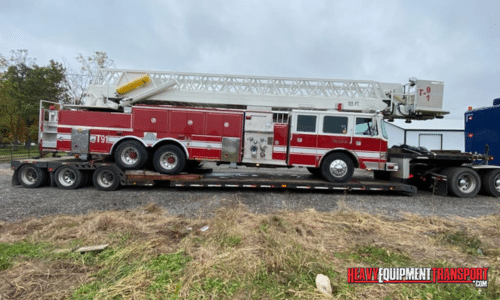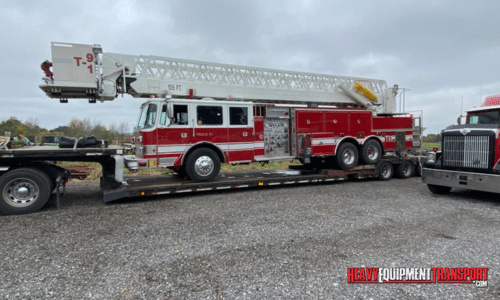The Anatomy of a Fire Truck: Understanding Its Transport Needs

William Thomas / January 2021
Fire vehicles are essential in emergency response processes. When calamity hits, their unique anatomy is specifically intended to serve various purposes. Aside from transporting firefighters, they are outfitted with water hoses, pumps, aerial platforms, and numerous rescue tools, all essential in firefighting and rescue operations.
As a result, the transportation requirements of fire trucks exceed those of regular vehicles. They require roadways that can handle their weight and navigation routes that can accommodate their dimensions due to their weight and size. Furthermore, the urgency of their operations necessitates open, unimpeded approaches to their objectives. In this blog, we will look at the structural details of fire engines and how they affect their transport requirements.

The History of the Fire Truck

Fire trucks as we know them now emerged from 17th-century crude hand pumps. These rudimentary models relied on human power and needed to be transported in miniature carts. With the invention of the steam engine in the nineteenth century, horse-drawn steam pumpers, which provided higher water pressure and capacity, became the backbone of firefighting. Their immense size, however, needed broader, sturdier highways.
The twentieth century saw the introduction of motorized fire trucks, which allowed for faster response times and broader range, but their increased weight necessitated further improvements in road infrastructure. Fire trucks today are larger and heavier than ever, with innovative equipment such as aerial ladders, foam systems, and specialized rescue gear, demanding clear, robust transportation networks. As a result, as fire engines’ design and capabilities have developed, so have their transportation requirements, pushing breakthroughs in infrastructure construction.
“Because of their size, weight, and equipment, fire vehicles have special transportation requirements and may encounter a number of obstacles.”
The Modern Fire Truck
The modern fire truck is an extremely sophisticated machine built to satisfy the ever-increasing firefighting needs. Let’s take a deeper look at the numerous parts that go into making this remarkable car.
- Chassis and Frame: The Fire Truck’s Foundation – The chassis and frame are the foundation of any fire truck, serving as a strong foundation for all other components. These parts are built to endure the weight and stress of transporting big equipment and the rigors of emergency response. Specialized materials and technical processes are used to achieve maximum durability and strength.
- Engine and Drivetrain: The Truck’s Engine and Drivetrain – The engine and drivetrain are critical for rapid reaction times, allowing fire engines to arrive at their destination as soon as possible. Fire trucks are outfitted with powerful engines capable of producing high levels of torque, helping them to drive through traffic and difficult terrain. The drivetrain is also important for maneuverability and stability, making it a crucial component of the fire truck’s design.
- Water Pump and Tank: The Primary Firefighting Tools – The key tools for battling flames are the water pump and tank. The pump delivers water to the hoses, which firefighters use to direct water towards the flames. The tank holds a significant volume of water and is available in various sizes to meet various demands. Furthermore, modern technology has enabled the integration of foam systems into fire trucks, allowing even greater efficiency in fire extinguishment.
- Hoses and Ladders: Essential Firefighting Equipment – Hoses and ladders are essential for fire vehicles because they allow firemen to access various regions and angles when combating flames. Hoses are available in various lengths and diameters to fit diverse scenarios, whilst ladders give height and reach to combat fires in multi-story buildings. Both are made of lightweight materials, making them easier for firemen to handle.

Transport Your Fire Truck Today
Heavy Equipment Transport is always available for a quote. Fill out the form or give us a call now! (888) 730-2951

Transporting A Fire Truck The Right Way
Because of their size, weight, and equipment, fire vehicles have special transportation requirements and may encounter a number of obstacles.
- Weight Considerations: Because fire trucks are loaded with heavy equipment, they are significantly heavier than regular vehicles. This weight impacts their handling, fuel consumption, and the necessity for strong transportation platforms should they need to be transported.
- Precautions for Safety: The movement of a fire truck must ensure the truck’s and its equipment’s safety and security. To avoid damage or mishaps during transport, meticulous planning and adherence to safety protocols are required.
- Custom Vehicles: Due to their unique design or features, existing specialized transport vehicles may not be suitable for transporting specific types of fire trucks in some circumstances. This may need the creation of custom-made transport vehicles, increasing the cost and complexity of transportation.
Fire Truck Transport, Maintenance, and Storage
Maintaining and storing fire trucks during transport is necessary to ensure their functionality and longevity. Regular inspections and maintenance are required to discover and fix mechanical flaws as soon as possible, avoiding operational breakdowns during emergencies. To avert environmental damage, protective measures must be implemented. This involves covering the fire vehicle to protect it from inclement weather and ensuring it is properly tied to avoid movement during travel. Furthermore, careful planning is essential to guarantee that storage conditions during shipment, such as temperature and humidity, do not harm the fire truck and its equipment.
To summarize, understanding the anatomy of a fire engine is critical not only for its operation but also for its transportation. Each characteristic, whether it’s size, weight, or specialized equipment, impacts the mode of transportation, logistics, and maintenance requirements. By recognizing these intricacies, we can assure the safe and effective transportation of these critical vehicles, reducing possible delays and expenses and, in the end, improving our emergency response capabilities. It’s a complicated procedure that demands meticulous planning and attention to detail, but the significance of ensuring our fire vehicles arrive safely and ready to go cannot be understated.

William Thomas
Heavy Transport Specialist
Being able to lead a team of such talented logistics agents has been a wonderful experience over the past ten years. If you would like to know anything more about the heavy equipment transport services we offer, don't hesitate to give us a call!